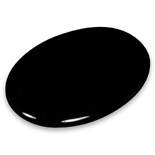
Alternative Names: Volcanic Glass, Apache Tears, Black Lava Glass
Origin: Worldwide, notably Mexico
Mineral Species: N/A
Mineral Group: N/A - a natural volcanic glass
Chemical Formula: ~SiO2
Hardness: 7
Crystal System: N/A
Colour: Typically black, but many variations occur.
Typical Appearance: Obsidian is considered to be a rock, not a mineral, because of the wide variety of minerals it contains, and technically can have any chemical composition. Mindat states that it is a mixture of cryptocrystalline grains of silica minerals held in a glass-like suspension – in other words, a super-cooled liquid, formed near the end of a volcanic eruption, when water and most of the other elements have already been ejected, leaving mainly silica, which then cools too quickly to crystallise. One explanation is as follows: one of the most unusual types of volcano is the rhyolite volcano, in which the magma has a high silica content, making it viscous. This viscosity prevents gas from being easily released from the magma, usually resulting in an explosive eruption, as in pyroclastic flow. Once the explosion has degassed the volcano, the remaining high-silicate magma extrudes slowly onto the surface, cooling quickly to form the glass-like mineral we know as obsidian.
Birthstone: Capricorn
Chakra Alignment: Root (Base)
Element: Earth
Origin of Name & Mythology: From the Roman Obsius, who, according to Pliny, was the discoverer of a similar mineral in Ethiopia (the added “d” was due to a printer’s error in the 14th or 15th century). Obsidian has a concoidal fracture, making it an excellent material for use in tools and weapons, and it has been used as such in the Americas, where is more common than flint. Ancient Greeks and ancient Aztecs also used it for mirrors, as it is highly reflective when polished. Dr Dee (1527 – 1608 - noted English mathematician, astronomer, astrologer, occultist, navigator, imperialist, and consultant to Queen Elizabeth I) apparently used a black mirror, believed to be obsidian, as one of his scrying tools.
Obsidian represents the potential we are born with, in suspension, before it begins to crystallise. All obsidians ground and protect, root spiritual energy, and dissolve shock, fear, pain & energy blocks. Obsidian aids inner reflection, and helps us to release addiction and unhealthy behaviour patterns. For many its grounding and protecting qualities are very comforting. In this capacity, obsidian is recommended for stress, anxiety and addiction.
Obsidian is also used for scrying mirrors and crystal balls, due to its glossy shine. Obsidian crystallised extremely quickly, which produces a smooth finish and no visible crystals. This gives it a very pure black colour and a high shine perfect for scrying. The exact way in which it crystallises can result in a few different varieties of obsidian.
Gold or Silver Sheen Obsidian
The gold or silver sheen is formed by tiny distributed gas bubbles trapped in the obsidian as it cools. In addition to obsidian's general properties, sheen obsidian is particularly used in scrying.
Rainbow Obsidian
Rainbow obsidian is black with bands of colour created by light refraction of water trapped in the glass as it cooled. It forms in green, purple, pink or blue, sometimes in a 'bull's eye' pattern. Rainbow obsidian is good for energetic balancing.
Snowflake Obsidian
As obsidian begins to crystallise it can form small inclusions of grey feldspar, which creates the delicate "snowflakes" in this crystal. Snowflake obsidian is associated with purity and balance of the mind, body and spirit. It is said to be beneficial for the skin and circulation.
Chakra Alignment: Root
Zodiac: Capricorn